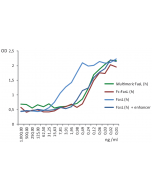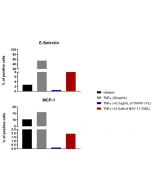Cookie Policy: This site uses cookies to improve your experience. You can find out more about our use of cookies in our Privacy Policy. By continuing to browse this site you agree to our use of cookies.
AdipoGen Life Sciences
TNF-α (mouse) (multimeric) (rec.)
| Product Details | |
|---|---|
| Synonyms | MultimericTNF-α™; ACRP30headless:TNF-α; ACRP30headless:TNFSF2; ACRP30headless:Tumor Necrosis Factor-α |
| Product Type | Protein |
| Properties | |
| Source/Host | HEK 293 cells |
| Sequence | The extracellular domain of mouse TNF-α (aa 77-235) is fused at the N-terminus to mouse ACRP30headless (aa 18-111) and a FLAG®-tag. |
| Crossreactivity |
Human Mouse |
| Specificity | Binds to human and mouse TNF-R1 and TNF-R2. |
| Biological Activity | Activates human and mouse TNF-R1 and TNF-R2. Induces cell death at a concentration range of 0.01-10ng/ml (ED50= 0.05ng/ml or 2 x 10E7 Units/mg; WEHI 164 cells). |
| MW | ~34kDa (SDS-PAGE) |
| Purity | ≥95% (SDS-PAGE) |
| Endotoxin Content | <0.02EU/μg purified protein (LAL test; Lonza). |
| Concentration | 0.1mg/ml after reconstitution. |
| Reconstitution | Reconstitute with 100μl sterile water. |
| Formulation | Lyophilized. Contains PBS. |
| Other Product Data |
UniProt link P06804: TNF-α (mouse) FLAG is a registered trademark of Sigma-Aldrich Co. |
| Shipping and Handling | |
| Shipping | BLUE ICE |
| Short Term Storage | +4°C |
| Long Term Storage | -20°C |
| Handling Advice |
After reconstitution, prepare aliquots and store at -20°C. Avoid freeze/thaw cycles. Centrifuge lyophilized vial before opening and reconstitution. PBS containing at least 0.1% BSA should be used for further dilutions. |
| Use/Stability |
Stable for at least 6 months after receipt when stored at -20°C. Working aliquots are stable for up to 3 months when stored at -20°C. |
| Documents | |
| MSDS |
 Download PDF Download PDF |
| Product Specification Sheet | |
| Datasheet |
 Download PDF Download PDF |
Tumor necrosis factor (TNF, cachexin or cachectin and formerly known as tumor necrosis factor-α) is a cytokine involved in systemic inflammation and is a member of a group of cytokines that stimulate the acute phase reaction. MultimericTNF-α™ is a high activity construct in which two trimeric TNF-α ligands are artificially linked via the collagen domain of ACRP30. The receptor TNF-R1 is activated by both the membrane-bound and soluble trimeric forms of TNF-α, whereas the receptor TNF-R2 only responds to the membrane-bound form of TNF-α (TNF-α (mouse) (multimeric) (rec.) (Prod. No. AG-40B-0021). Since the MultimericTNF-α™ mimics the membrane-bound form (forms oligomers higher than trimer), it is the only TNF-α protein that can activate the TNF-R2. For TNF-R1 activation, either "normal" TNF-α or MultimericTNF-α™ can be used.








